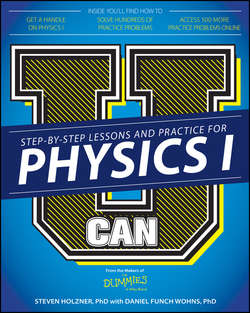Читать книгу U Can: Physics I For Dummies - Steven Holzner - Страница 10
На сайте Литреса книга снята с продажи.
Part I
Chapter 2
Reviewing Physics Measurement and Math Fundamentals
Measuring the World around You and Making Predictions
ОглавлениеPhysics excels at measuring and predicting the physical world – after all, that’s why physics exists. Measuring is the starting point – part of observing the world so you can then model and predict it. You have several different measuring sticks at your disposal: some for length, some for mass or weight, some for time, and so on. Mastering those measurements is part of mastering physics.
To keep like measurements together, physicists and mathematicians have grouped them into measurement systems. The most common measurement system you see in introductory physics is the meter-kilogram-second (MKS) system, referred to as SI (short for Système International d’Unités, the International System of Units), but you may also come across the foot-pound-second (FPS) system. Table 2-1 lists the primary units of measurement in the MKS system, along with their abbreviations.
Table 2-1 MKS Units of Measurement
These are the measuring sticks that will become familiar to you as you solve problems and triumph over the math in this book. Also for reference, Table 2-2 shows the primary units of measurement (and their abbreviations) in the CGS system. (Don’t bother memorizing the ones you’re not familiar with now; you can come back to them later as needed.)
Table 2-2 CGS Units of Measurement
Warning: Because different measurement systems use different standard lengths, you can get several different numbers for one part of a problem, depending on the measurement you use. For example, if you’re measuring the depth of the water in a swimming pool, you can use the MKS measurement system, which gives you an answer in meters, or the less common FPS system, in which case you determine the depth of the water in feet. The point? When working with equations, stick with the same measurement system all the way through the problem. If you don’t, your answer will be a meaningless hodgepodge, because you’re switching measuring sticks for multiple items as you try to arrive at a single answer. Mixing up the measurements causes problems – imagine baking a cake where the recipe calls for 2 cups of flour, but you use 2 liters instead.
Examples
Q. You’re told to measure the length of a racecar track using the MKS system. What unit(s) will your measurement be in?
A. The correct answer is meters. The unit of length in the MKS system is the meter.
Q. You’re told to measure the mass of a marble using the CGS system. What unit(s) will your measurement be in?
A. The correct answer is grams. The unit of mass in the CGS system is the gram.
Practice Questions
1. You’re asked to measure the time it takes the moon to circle Earth using the MKS system. What will your measurement’s units be?
2. You need to measure the force a tire exerts on the road as it’s moving using the MKS system. What are the units of your answer?
3. You’re asked to measure the amount of energy released by a firecracker when it explodes using the CGS system. What are the units of your answer?
Practice Answers
1. seconds. The unit of time in the MKS system is the second.
2. newtons. The unit of force in the MKS system is the newton.
3. ergs. The unit of energy in the CGS system is the erg.
